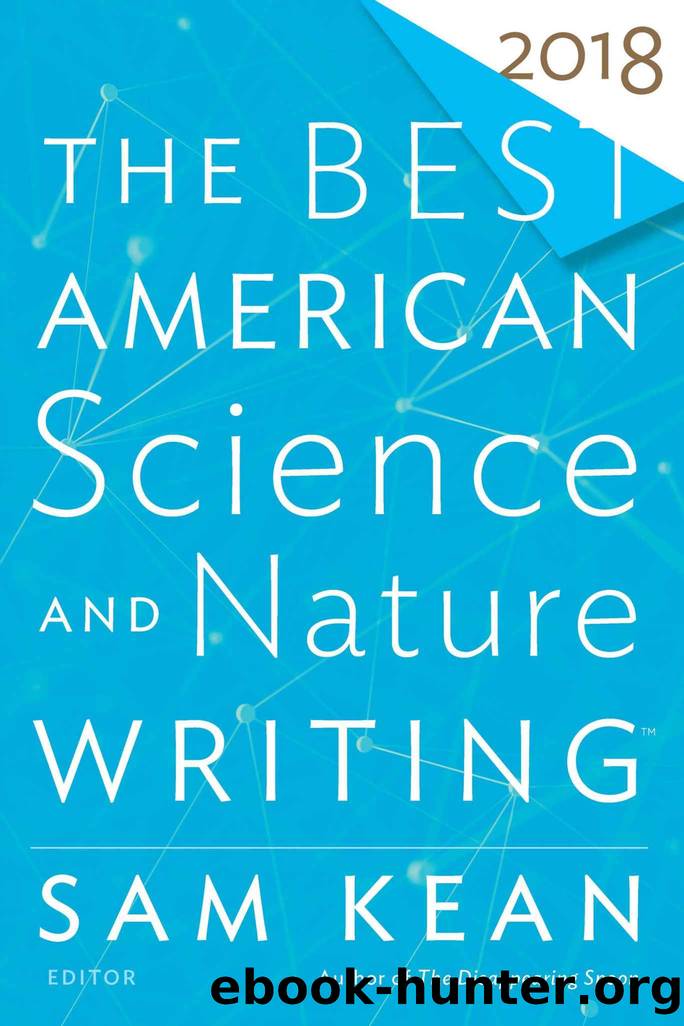The Best American Science and Nature Writing 2018 (The Best American Series ®) by Sam Kean

Author:Sam Kean
Language: eng
Format: mobi
Publisher: HMH Books
Published: 2018-10-01T16:00:00+00:00
PAUL KVINTA
David Haskell Speaks for the Trees
FROM Outside
DAVID HASKELLâS BRADFORD PEAR tree stands at the northwest corner of 86th Street and Broadway on Manhattanâs Upper West Side, and when we meet there one afternoon in July, he mentions that he hasnât spent quality time with the tree in nearly three months.
The previous occasion he visited, he and his girlfriend, Katie Lehman, were traveling by car to Maine from Sewanee, Tennessee, where Haskell is a professor of biology and environmental studies at the University of the South. They parked on the street, made their way to this corner, and proceeded to loiter, since thereâs nowhere to sit. It was late in the day. Trucks and buses barreled down Broadway. Sirens wailed. Pedestrians flowed past the tree, faces in their phones, while below ground the Seventh Avenue Express hammered by. The treeâs fallen white blossoms whirled in the evening gusts, and discarded wads of gum littered the dirt at the base of its trunk. For an hour and a half Haskell watched. He listened. Then he and Lehman got back in their car and drove to Maine.
âIt was amazing sharing the tree with Katie, introducing her to this creature Iâd spent so much time with,â Haskell tells me now. âTo be able to wrap other people into my relationship with the tree, and the tree into my relationship with other peopleâitâs very enriching.â
Introducing me to the tree, then, is a pretty big deal.
âThis is it,â he says, beaming.
We eyeball the tree.
âYes,â I say.
Itâs not exactly beautiful. Itâs not exactly ugly. It reaches maybe 30 feet tall, with an oval canopy of dark waxy leaves and a gray trunk streaked green with algae. A couple of diseased limbs have been removed, leaving pitted nubs. It grows in front of a Banana Republic, between a newsstand and some newspaper boxes, and nearby thereâs a flight of stairs leading down to the 86th Street subway platform. At the base of the trunk, some well-tended pink and white periwinkles share a patch of dirt with two cigarette butts, half a grape, a plastic drink lid, and a couple of straws. Locked to the short iron fence that surrounds the trunk is a blue bicycle missing its seat. Another Bradford pear sprouts from the sidewalk 30 feet north of this one, then another one north of that, then another. There are six of them on this block alone.
Haskellâs tree is utterly average.
He is not offended by this assessment. In fact, itâs one of the reasons he includes the Bradford pear in his book, The Songs of Trees: Stories from Natureâs Great Connectors, which comes out in April. âThis tree appeals to me because itâs a regular street tree,â he tells me. âThere are some trees in Manhattan that are famous, like the 9/11 Survivor Tree. People actually travel great distances to see that tree. No one travels to Manhattan to see this tree.â Except Haskell. And now me.
He had invited me to spend a couple of days with him here.
Download
This site does not store any files on its server. We only index and link to content provided by other sites. Please contact the content providers to delete copyright contents if any and email us, we'll remove relevant links or contents immediately.
Sapiens: A Brief History of Humankind by Yuval Noah Harari(14165)
Sapiens by Yuval Noah Harari(5264)
Pale Blue Dot by Carl Sagan(4858)
Homo Deus: A Brief History of Tomorrow by Yuval Noah Harari(4777)
Livewired by David Eagleman(3624)
Origin Story: A Big History of Everything by David Christian(3590)
Brief Answers to the Big Questions by Stephen Hawking(3319)
Inferior by Angela Saini(3209)
Origin Story by David Christian(3117)
The Gene: An Intimate History by Siddhartha Mukherjee(3014)
Signature in the Cell: DNA and the Evidence for Intelligent Design by Stephen C. Meyer(2996)
The Evolution of Beauty by Richard O. Prum(2914)
Aliens by Jim Al-Khalili(2764)
How The Mind Works by Steven Pinker(2695)
A Short History of Nearly Everything by Bryson Bill(2578)
Sex at Dawn: The Prehistoric Origins of Modern Sexuality by Ryan Christopher(2441)
From Bacteria to Bach and Back by Daniel C. Dennett(2423)
Endless Forms Most Beautiful by Sean B. Carroll(2402)
Who We Are and How We Got Here by David Reich(2375)
